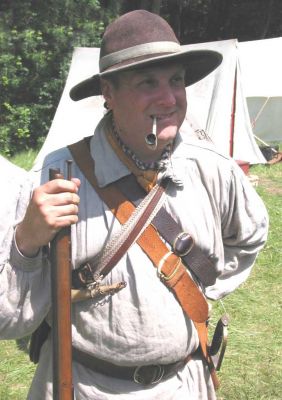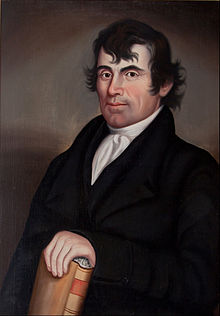Logan's Company was founded on the proposition that our recreated militia would rely on DOCUMENTED facts about clothing, equipment, appearance, and mannerisms. For 25 years, through changing leadership, we have maintained the desire to field a militia with an acceptable level of authenticity.
The Militia in Kentucky
By Logan's Cofounder, Capt. Ron Poppe
The Militia was formed in Kentucky by the Virginia legislature in 1776. Every man age 16 to 60 was to be in the Militia. They were the farmers and settlers of the new Virginia County of Kentucky. John Bowman was made the County Lieutenant of Kentucky county. George Rogers Clark was made Major. And Daniel Boone, James Harrod, John Todd and Benjamin Logan were Captains. There were three major settlements in Kentucky at this time, Harrodsburg, Boonesborough and Logan’s Fort, all of which, including the smaller settlements and stations had sustained Indian attacks and sieges.
At Boonesborough one Sunday afternoon Shawnees captured Daniel Boone's daughter along with two other girls from the fort. Boone quickly gathered some Militiamen and gave chase. Boone knew the trail the Indians were taking and took a short cut. They found the Indians and their captives at camp thinking they were well ahead of the frontiersmen. The Militia opened fire killing one and the rest scattered to the north enabling them to save the kidnapped girls.[1]
Early in 1777 near Harrodsburg, Chief Blackfish and his warriors attacked William Ray’s sugar camp. The sugar maker’s broke and ran in every direction. William’s brother, James thought they should surrender. But William did not and turned to fight. He was badly wounded as James ran back to the fort to give the alarm. The Militia was called up and when they returned to the site they found the found William Ray's body so badly mutilated they could not identify it. And a short time later a man was scalped one hundred yards from the fort while his family watched in horror. [2]
In May of 1777 at the site of Logan’s Fort, a terrifying incident happened. On the frontier the cattle were left to forage in the woods on their own. Each morning the women of Logan’s Fort would be escorted out with a number of men as guards to do the milking. On this particular day while the women were milking the cows, a large number of Indians attacked. As the women ran for their lives the four men sent to protect them fired back at their attackers. During the exchange of gunfire two of the Kentucky militiamen were hit. They were William Hudson and Bur Harrison. Hudson was killed instantly while Harrison lay mortally wounded on the ground. Captain Benjamin Logan knew that something had to be done or Harrison would most certainly be killed. He asked for volunteers to go with him to save the injured man. When he didn’t get any response he decided to go alone. Using a large bail of wool he rolled it in front of him as a shield. Making his way to the half-dead Harrison he picked him up and ran back to the safety of the fort. When he returned and the gate was shut the settlers watched in horror as the Indians lifted the scalp of William Hudson in full view of the fort.[3] After these attacks and many other small skirmishes the year of 1777 became known as the year of the bloody sevens.
By 1779 the Virginia frontier of Kentucky County became known as, the “Dark and Bloody Ground” and George Rogers Clark had taken Fort Sackville at Vincennes and captured the Lt. Governor of Detroit Henry Hamilton. Also known as the Hair buyer by the settlers of Kentucky as it was thought that he bought scalps from the Indians that they had taken in Kentucky. Also by this time Col. Bowman had led an expedition to the Indian town of Chillicothe with the Kentucky Militia. The campaign was far from successful with few of the enemy killed and very little plunder taken. Mostly blankets, guns, pots, trade silver and a few horses. The items were auctioned off when they reached the Ohio River and the money was used to pay the Militia for their time on duty.
In 1780 Kentucky County split into three separate counties: Jefferson, Fayette and Lincoln. John Floyd was appointed County Lt. of Jefferson County; John Todd was appointed County Lt. for Fayette and Benjamin Logan to be made County Lt. of Lincoln.[4]
In June of 1780 a large party of Shawnee with a detachment of British regulars commanded by Capt. Byrd of the 8th Regiment of Foot captured the inhabitants of Martins and Ruddles Stations. After this Clark decided to attack the Indian town of Piqua. The settlers were more concerned with land than with a campaign. Clark dealt with them by closing the surveyor’s office and placing a guard at the wilderness trail with orders not to let anyone leave the county. Benjamin Logan was placed second in command of the campaign. Logan gave orders to the captains of the militia to call up four-fifths of the men in their counties for duty. They were to rendezvous at the mouth of the Licking River (across the Ohio River from present day Cincinnati), leaving the rest behind to guard the settlements and keep them supplied with meat. Logan’s regiment consisted of 328 men from 8 different companies. These companies varied in size, as was often the case in the backcountry settlements.
Every man was to furnish his own supplies. Every six men were to form a mess and had a packhorse to carry their blankets, kettles, axes, parched corn and salt. Most men were dressed in the typical backcountry fashion of hunting shirt, breechclout, hat, moccasins and leggings. Knee breeches, coats, waistcoats, shoes both buckle and lace up were also worn. Hats had short or wide brims some cocked. Others wore cloth or knit caps.[5] Their weapons consisted of everything from long rifles to fowlers, muskets of every type and a few blunder busts. They carried scalping knives, tomahawks, belt axes, hunting swords and a few bayonets. Some had cartridge boxes but most used hunting pouch and powder horns. All of these items were to be furnished by the soldier (Militiaman) himself.
[1] Daniel Boone by John Bakeless page 124-140
[2] Daniel Boone by John Bakeless page 146-148
[3] Talbert ; Benjamin Logan ; University of Kentucky Press
[4] Draper Mss. 51 j 104; 11 s 48. James (ed.), Clark Papers, 1771-1781, clx, note 4.
[5] Henry Wilson’s account Draper manuscripts.

